#middleware solutions
Explore tagged Tumblr posts
Text
Innovate, inspire, achieve—turn your dreams into digital realities
WBC Software Lab | Software Development & IT Solutions | Karaikudi
Are you ready to bring your ideas to life? At Wbc Software Lab, we specialize in crafting beautiful, functional websites and applications that help your business stand out in the digital world.
Whether you need a sleek, user-friendly website or a powerful, custom application, we have the expertise to deliver exactly what you're looking for. Our team of experts works closely with you to understand your vision and turn it into reality.

#software development#IT solutions#ERP#.NET#PHP development#Karaikudi#IT training#cloud services#mobile app development#enterprise integration#middleware solutions#Tally ERP#business management software
0 notes
Text
Connecting the Dots: The Importance of Lab Analyzers Interfacing

In the intricate tapestry of laboratory operations, the seamless integration of lab analyzers is paramount. From chemistry analyzers to hematology instruments, each component plays a vital role in the diagnostic process. However, the true magic happens when these disparate pieces come together through lab analyzers interfacing. This synergy not only streamlines workflow but also enhances the efficiency and accuracy of diagnostic testing.
At the heart of lab analyzers interfacing lies instrument integration. Gone are the days of siloed instruments operating in isolation. Modern laboratories demand interconnectedness, where analyzers communicate harmoniously to deliver cohesive results. Through advanced integration protocols, laboratories can orchestrate a symphony of analyses, maximizing throughput and minimizing turnaround times.
Yet, integration is merely the first step. The crux of lab analyzers interfacing lies in data transfer. Patient samples traverse a labyrinth of analyzers, each generating a plethora of data points. Efficient data transfer mechanisms ensure that these valuable insights flow seamlessly from one instrument to another, without loss or distortion. Whether it's transmitting test results or patient demographics, the integrity of data transfer is sacrosanct.

However, the path to seamless interfacing is fraught with challenges, chief among them being compatibility testing. Not all analyzers speak the same language or adhere to uniform data standards. Compatibility testing is akin to deciphering a complex code, ensuring that disparate instruments can understand and interpret each other's signals. Through meticulous testing protocols, laboratories can preempt compatibility issues and preemptively resolve them.
Moreover, effective interface configuration is essential for optimizing analyzers' interoperability. Customized configurations tailor interfaces to the unique needs of each laboratory, ensuring smooth data exchange and minimizing errors. Whether it's defining data formats or establishing communication protocols, meticulous interface configuration is the linchpin of successful lab analyzers interfacing.
In the realm of lab analyzers interfacing, middleware solutions serve as the bridge between disparate instruments. These software platforms harmonize data exchange, transcending the barriers of instrument heterogeneity. Middleware solutions not only facilitate seamless interfacing but also offer advanced functionalities such as result validation and autoverification, further enhancing laboratory efficiency and quality.
In conclusion, lab analyzers interfacing is the linchpin of modern laboratory operations, fostering synergy among disparate instruments and maximizing the efficiency and accuracy of diagnostic testing. Through the seamless integration of instruments, efficient data transfer mechanisms, meticulous compatibility testing, customized interface configurations, and middleware solutions, laboratories can unlock new frontiers of efficiency and excellence. As laboratories continue to evolve in tandem with technological advancements, the importance of lab analyzers interfacing will only grow, cementing its status as a cornerstone of diagnostic excellence.
#Instrument Integration#Data Transfer#Compatibility Testing#Interface Configuration#Middleware Solutions
0 notes
Text
Unified Middleware API Platform
A Unified Middleware API Platform is a software solution that provides a single, centralized point of integration for all of an organization's APIs and data sources. It acts as a middleware layer, sitting between the different APIs and services, and providing a consistent API design and developer experience.
#Unified Api Platform#Middleware Platform#ESB middleware#Enterprise Service bus middleware#Enterprise service bus solutions
0 notes
Text
Integrating Third-Party Tools into Your CRM System: Best Practices
A modern CRM is rarely a standalone tool — it works best when integrated with your business's key platforms like email services, accounting software, marketing tools, and more. But improper integration can lead to data errors, system lags, and security risks.

Here are the best practices developers should follow when integrating third-party tools into CRM systems:
1. Define Clear Integration Objectives
Identify business goals for each integration (e.g., marketing automation, lead capture, billing sync)
Choose tools that align with your CRM’s data model and workflows
Avoid unnecessary integrations that create maintenance overhead
2. Use APIs Wherever Possible
Rely on RESTful or GraphQL APIs for secure, scalable communication
Avoid direct database-level integrations that break during updates
Choose platforms with well-documented and stable APIs
Custom CRM solutions can be built with flexible API gateways
3. Data Mapping and Standardization
Map data fields between systems to prevent mismatches
Use a unified format for customer records, tags, timestamps, and IDs
Normalize values like currencies, time zones, and languages
Maintain a consistent data schema across all tools
4. Authentication and Security
Use OAuth2.0 or token-based authentication for third-party access
Set role-based permissions for which apps access which CRM modules
Monitor access logs for unauthorized activity
Encrypt data during transfer and storage
5. Error Handling and Logging
Create retry logic for API failures and rate limits
Set up alert systems for integration breakdowns
Maintain detailed logs for debugging sync issues
Keep version control of integration scripts and middleware
6. Real-Time vs Batch Syncing
Use real-time sync for critical customer events (e.g., purchases, support tickets)
Use batch syncing for bulk data like marketing lists or invoices
Balance sync frequency to optimize server load
Choose integration frequency based on business impact
7. Scalability and Maintenance
Build integrations as microservices or middleware, not monolithic code
Use message queues (like Kafka or RabbitMQ) for heavy data flow
Design integrations that can evolve with CRM upgrades
Partner with CRM developers for long-term integration strategy
CRM integration experts can future-proof your ecosystem
#CRMIntegration#CRMBestPractices#APIIntegration#CustomCRM#TechStack#ThirdPartyTools#CRMDevelopment#DataSync#SecureIntegration#WorkflowAutomation
2 notes
·
View notes
Text
Cloud Migration and Integration A Strategic Shift Toward Scalable Infrastructure
In today’s digital-first business environment, cloud computing is no longer just a technology trend—it’s a foundational element of enterprise strategy. As organizations seek greater agility, scalability, and cost-efficiency, cloud migration and integration have emerged as critical initiatives. However, transitioning to the cloud is far from a lift-and-shift process; it requires thoughtful planning, seamless integration, and a clear understanding of long-term business objectives.

What is Cloud Migration and Why Does It Matter
Cloud migration involves moving data, applications, and IT processes from on-premises infrastructure or legacy systems to cloud-based environments. These environments can be public, private, or hybrid, depending on the organization’s needs. While the move offers benefits such as cost reduction, improved performance, and on-demand scalability, the true value lies in enabling innovation through flexible technology infrastructure.
But migration is only the first step. Cloud integration—the process of configuring applications and systems to work cohesively within the cloud—is equally essential. Without integration, businesses may face operational silos, inconsistent data flows, and reduced productivity, undermining the very purpose of migration.
Key Considerations in Cloud Migration
A successful cloud migration depends on more than just transferring workloads. It involves analyzing current infrastructure, defining the desired end state, and selecting the right cloud model and service providers. Critical factors include:
Application suitability: Not all applications are cloud-ready. Some legacy systems may need reengineering or replacement.
Data governance: Moving sensitive data to the cloud demands a strong focus on compliance, encryption, and access controls.
Downtime management: Minimizing disruption during the migration process is essential for business continuity.
Security architecture: Ensuring that cloud environments are resilient against threats is a non-negotiable part of migration planning.
Integration for a Unified Ecosystem
Once in the cloud, seamless integration becomes the linchpin for realizing operational efficiency. Organizations must ensure that their applications, databases, and platforms communicate efficiently in real time. This includes integrating APIs, aligning with enterprise resource planning (ERP) systems, and enabling data exchange across multiple cloud platforms.
Hybrid and Multi-Cloud Strategies
Cloud strategies have evolved beyond single-provider solutions. Many organizations now adopt hybrid (combining on-premise and cloud infrastructure) or multi-cloud (using services from multiple cloud providers) approaches. While this enhances flexibility and avoids vendor lock-in, it adds complexity to integration and governance.
To address this, organizations need a unified approach to infrastructure orchestration, monitoring, and automation. Strong integration frameworks and middleware platforms become essential in stitching together a cohesive IT ecosystem.
Long-Term Value of Cloud Transformation
Cloud migration and integration are not one-time projects—they are ongoing transformations. As business needs evolve, cloud infrastructure must adapt through continuous optimization, cost management, and performance tuning.
Moreover, integrated cloud environments serve as the foundation for emerging technologies like artificial intelligence, data analytics, and Internet of Things (IoT), enabling businesses to innovate faster and more efficiently.
By treating cloud migration and integration as strategic investments rather than tactical moves, organizations position themselves to stay competitive, agile, and future-ready.
#CloudMigration#CloudIntegration#DigitalTransformation#HybridCloud#MultiCloud#CloudComputing#InfrastructureModernization#ITStrategy#BusinessContinuity
2 notes
·
View notes
Text
Protect Your Laravel APIs: Common Vulnerabilities and Fixes
API Vulnerabilities in Laravel: What You Need to Know
As web applications evolve, securing APIs becomes a critical aspect of overall cybersecurity. Laravel, being one of the most popular PHP frameworks, provides many features to help developers create robust APIs. However, like any software, APIs in Laravel are susceptible to certain vulnerabilities that can leave your system open to attack.

In this blog post, we’ll explore common API vulnerabilities in Laravel and how you can address them, using practical coding examples. Additionally, we’ll introduce our free Website Security Scanner tool, which can help you assess and protect your web applications.
Common API Vulnerabilities in Laravel
Laravel APIs, like any other API, can suffer from common security vulnerabilities if not properly secured. Some of these vulnerabilities include:
>> SQL Injection SQL injection attacks occur when an attacker is able to manipulate an SQL query to execute arbitrary code. If a Laravel API fails to properly sanitize user inputs, this type of vulnerability can be exploited.
Example Vulnerability:
$user = DB::select("SELECT * FROM users WHERE username = '" . $request->input('username') . "'");
Solution: Laravel’s query builder automatically escapes parameters, preventing SQL injection. Use the query builder or Eloquent ORM like this:
$user = DB::table('users')->where('username', $request->input('username'))->first();
>> Cross-Site Scripting (XSS) XSS attacks happen when an attacker injects malicious scripts into web pages, which can then be executed in the browser of a user who views the page.
Example Vulnerability:
return response()->json(['message' => $request->input('message')]);
Solution: Always sanitize user input and escape any dynamic content. Laravel provides built-in XSS protection by escaping data before rendering it in views:
return response()->json(['message' => e($request->input('message'))]);
>> Improper Authentication and Authorization Without proper authentication, unauthorized users may gain access to sensitive data. Similarly, improper authorization can allow unauthorized users to perform actions they shouldn't be able to.
Example Vulnerability:
Route::post('update-profile', 'UserController@updateProfile');
Solution: Always use Laravel’s built-in authentication middleware to protect sensitive routes:
Route::middleware('auth:api')->post('update-profile', 'UserController@updateProfile');
>> Insecure API Endpoints Exposing too many endpoints or sensitive data can create a security risk. It’s important to limit access to API routes and use proper HTTP methods for each action.
Example Vulnerability:
Route::get('user-details', 'UserController@getUserDetails');
Solution: Restrict sensitive routes to authenticated users and use proper HTTP methods like GET, POST, PUT, and DELETE:
Route::middleware('auth:api')->get('user-details', 'UserController@getUserDetails');
How to Use Our Free Website Security Checker Tool
If you're unsure about the security posture of your Laravel API or any other web application, we offer a free Website Security Checker tool. This tool allows you to perform an automatic security scan on your website to detect vulnerabilities, including API security flaws.
Step 1: Visit our free Website Security Checker at https://free.pentesttesting.com. Step 2: Enter your website URL and click "Start Test". Step 3: Review the comprehensive vulnerability assessment report to identify areas that need attention.
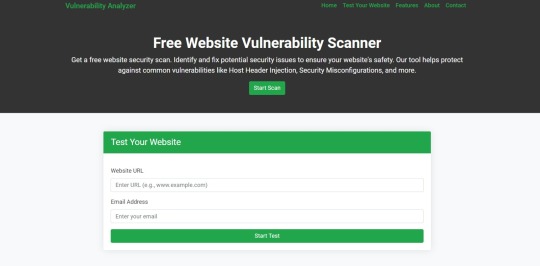
Screenshot of the free tools webpage where you can access security assessment tools.
Example Report: Vulnerability Assessment
Once the scan is completed, you'll receive a detailed report that highlights any vulnerabilities, such as SQL injection risks, XSS vulnerabilities, and issues with authentication. This will help you take immediate action to secure your API endpoints.
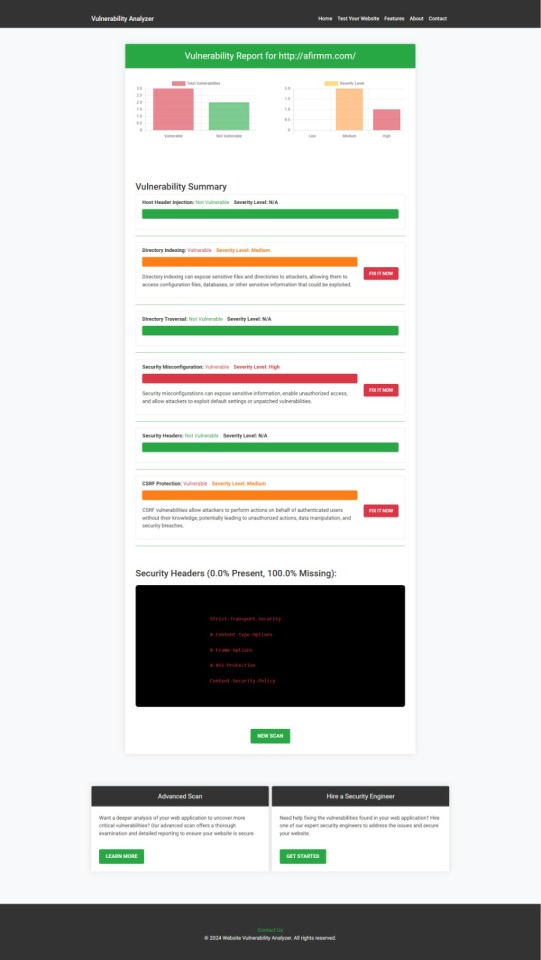
An example of a vulnerability assessment report generated with our free tool provides insights into possible vulnerabilities.
Conclusion: Strengthen Your API Security Today
API vulnerabilities in Laravel are common, but with the right precautions and coding practices, you can protect your web application. Make sure to always sanitize user input, implement strong authentication mechanisms, and use proper route protection. Additionally, take advantage of our tool to check Website vulnerability to ensure your Laravel APIs remain secure.
For more information on securing your Laravel applications try our Website Security Checker.
#cyber security#cybersecurity#data security#pentesting#security#the security breach show#laravel#php#api
2 notes
·
View notes
Text
Top 20 Backend Development Tools In 2023
Backend development plays a crucial role in the operation and performance optimisation of web and mobile applications, serving as their foundational framework. In the context of the dynamic technological environment, it is imperative for developers to remain abreast of the most recent and effective backend development technologies. In the year 2023, a plethora of advanced tools have surfaced, leading to a significant transformation in the approach to backend development. Reach out to Nivida Web Solutions - a noted Web development company in Vadodara and let's craft a website that sets you apart.
This analysis aims to examine the leading 20 backend development tools projected for the year 2023, which possess the potential to optimise operational effectiveness, raise work output, and achieve exceptional outcomes.
1. Node.js:
Node.js continues to be a prominent contender in the realm of backend development, offering a resilient framework for constructing scalable, server-side applications through the utilisation of JavaScript. The asynchronous and event-driven nature of the system renders it highly suitable for real-time applications and microservices.
2. Express.js:
Express.js is a Node.js framework that offers a basic and flexible approach to backend development. It achieves this by providing streamlined routing, efficient handling of HTTP requests, and effective management of middleware. The software possesses a high degree of extensibility, allowing developers to create tailored solutions.
3. Django:
Django, a renowned Python framework, is widely recognised for its exceptional performance, robust security measures, and remarkable scalability. The framework adheres to the "batteries-included" principle, providing a wide range of pre-installed functionalities and libraries that enhance the speed and efficiency of the development process.
4. Flask:
Flask, an additional Python framework, is characterised by its lightweight nature and user-friendly interface. The framework offers fundamental capabilities for backend development and enables developers to incorporate additional functionalities as required, thus rendering it very adaptable.
5. Spring Boot:
Spring Boot, which is built on the Java programming language, streamlines the process of creating applications that are ready for deployment by employing a convention-over-configuration methodology. The platform provides a variety of functionalities to construct resilient and scalable backend systems. Embark on a digital journey with Nivida Web Solutions - the most distinguished Web development company in Gujarat. Let's create a stunning, functional website tailored to your business!
6. Ruby on Rails:
Ruby on Rails, also referred to as Rails, is renowned for its high level of efficiency and user-friendly nature. The framework employs the Ruby programming language and places a strong emphasis on convention over configuration, facilitating expedited development processes.
7. ASP.NET Core:
ASP.NET Core is a highly adaptable and efficient cross-platform framework that facilitates the development of backend solutions through the utilisation of the C# programming language. The product provides exceptional performance, robust security measures, and effortless compatibility with many systems.
8. Laravel:
Laravel, a framework developed using the PHP programming language, is well-acknowledged for its sophisticated syntax and user-centric functionalities. The utilisation of this technology streamlines intricate operations such as authentication, caching, and routing, hence facilitating an expedited development procedure.
9. NestJS:
NestJS is a Node.js framework that adheres to the architectural patterns established by Angular, hence exhibiting a progressive nature. The software possesses a high degree of modularity, hence facilitating the scalability and maintenance of applications. NestJS places a strong emphasis on the principles of maintainability and testability.
10. RubyMine:
RubyMine is an influential integrated development environment (IDE) designed specifically for the purpose of facilitating Ruby on Rails development. The software provides advanced code assistance, navigation, and debugging functionalities, hence augmenting the efficiency of Ruby developers. Looking for a standout web presence? Let Nivida Web Solutions - the most popular Web development company in India craft a website that impresses. Reach out now and let's get started!
11. PyCharm:
PyCharm, an integrated development environment (IDE) designed specifically for the Python programming language, is extensively utilised in the realm of backend development. The software offers intelligent code completion, comprehensive code analysis, and integrated tools to facilitate fast development and debugging processes.
12. IntelliJ IDEA:
IntelliJ IDEA, a widely utilised integrated development environment (IDE), provides comprehensive support for multiple programming languages, encompassing Java, Kotlin, and many more. The software is renowned for its advanced coding assistance and efficient capabilities, which greatly assist backend developers in producing code of superior quality.
13. Visual Studio Code (VSCode):
VSCode is a code editor that is known for its lightweight nature and open-source nature. Due to its extensive extension library and high level of customizability, this platform is widely favoured by backend developers due to its versatile nature.
14. Postman
Postman is an efficient and powerful application programming interface (API) testing tool that streamlines the process of doing backend testing and facilitating communication among developers. This tool facilitates the efficient design, testing, and documentation of APIs, hence assuring a smooth integration process. Every click counts in the digital world. Partner with Nivida Web Solutions - one of the top Web development companies in Vadodara to create a user-friendly, engaging website. Choose Nivida Web Solutions to boost your online impact!
15. Swagger:
Swagger, currently recognised as the OpenAPI Specification, serves to enable the process of designing, documenting, and evaluating APIs. The standardised structure of API description facilitates the seamless and uncomplicated integration process.
16. MongoDB:
MongoDB, a widely adopted NoSQL database, has notable advantages in terms of scalability, flexibility, and superior performance. Due to its capacity to effectively manage substantial quantities of data and accommodate various data models, it is extensively employed in the realm of backend development.
17. PostgreSQL:
PostgreSQL, an open-source relational database management system, is widely recognised for its robustness, adaptability, and comprehensive SQL capabilities. This option is highly recommended for projects that necessitate a resilient backend data repository.
18. Redis:
Redis is an essential component for caching and real-time analytics due to its ability to store data structures in memory. The indispensability of this technology lies in its high performance and its capability to effectively manage data structures, hence facilitating the optimisation of backend processes.
19. Kafka:
Apache Kafka is a distributed streaming platform that handles real-time data processing. It's commonly used for building scalable, fault-tolerant backend systems that require high-throughput data ingestion and processing. Dive into the digital era with a website that wows! Collaborate with Nivida Web Solutions - one of the leading Web development companies in Gujarat and boost your online presence.
20. Docker:
Docker is a containerization technology that facilitates the streamlined deployment and scalability of programs. The utilisation of containers enables backend developers to encapsulate their programmes and associated dependencies, hence ensuring uniformity and adaptability across diverse contexts.
Final Thoughts:
It is of utmost importance for developers to be updated on the most recent backend development technologies in order to effectively offer applications that are efficient, scalable, and safe. The compendium of the foremost 20 backend development tools projected for the year 2023 encompasses an extensive array of functions, adeptly accommodating the multifarious requirements of backend development endeavours. These technologies provide developers with the ability to enhance their backend development endeavours and provide users with outstanding experiences, whether through the creation of real-time applications, database management, or performance optimisation. Your website is your digital storefront. Make it appealing! Contact Nivida Web Solutions - one of the most renowned Web development companies in India and design a website that captivates your audience. Get started now!
7 notes
·
View notes
Text
SAP Basis
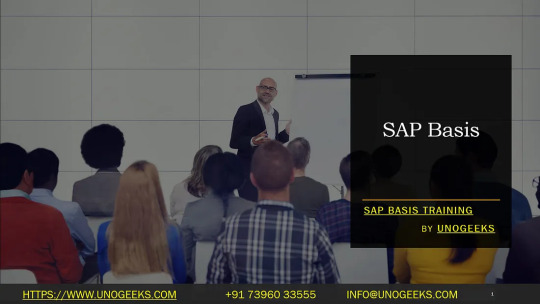
SAP Basis: The Backbone of Your SAP Landscape
SAP applications form the core of many modern enterprises. Financial data, customer interactions, supply chain logistics, and many other critical business operations rely on SAP’s robust solutions. But what powers these solutions? That’s where SAP Basis comes in.
What is SAP Basis?
In simple terms, SAP Basis is the technological foundation upon which SAP applications are built and run. It’s like the operating system specifically for your SAP world. Basis provides a set of middleware components and administration tools that ensure your SAP applications function smoothly and reliably.
Key Responsibilities of an SAP Basis Administrator
SAP Basis administrators are the unsung heroes of the SAP world, responsible for a wide range of tasks:
Installation and Configuration: Basis admins handle the initial installation and setup of SAP systems, ensuring they’re configured correctly for your business needs.
System Administration: They perform ongoing tasks like monitoring system health, applying patches and upgrades, and managing system resources.
Database Management: This includes database installation, configuration, backup and restore processes, and overall database health.
Performance Tuning: Basis admins identify bottlenecks, optimize settings, and ensure applications run at their peak.
User Management: Creating and managing user accounts, assigning roles and authorizations for secure access control.
Troubleshooting: When problems arise, these experts step up to diagnose and resolve issues promptly, minimizing downtime for the business.
Transport Management: They oversee the movement of code changes and configuration updates between different SAP environments (e.g., development, testing, production).
Components of SAP Basis
Some core components that make up SAP Basis include:
SAP NetWeaver: The core technology platform that provides the foundation for different SAP products.
ABAP Workbench: The development environment for creating custom ABAP code (SAP’s primary programming language).
SAP GUI: The graphical user interface used to interact with SAP systems.
Transport Management System: Tools for managing and tracking changes across SAP environments.
Solution Manager: A centralized platform for system monitoring, diagnostics, and support tools.
Why is SAP Basis Important?
Reliability and Stability: A well-managed SAP Basis system means your critical business applications will run smoothly, minimizing disruptions and downtime.
Performance: Basis expertise ensures that your SAP applications are optimized to deliver their best, promoting efficient business operations.
Security: Basis includes a suite of tools to manage user access, protect sensitive data, and ensure compliance with security standards.
Agility: A flexible Basis layer gives your business the ability to adapt to changing needs by scaling SAP deployments or introducing new components.
Becoming an SAP Basis Administrator
A career in SAP Basis is both challenging and rewarding. If you have a knack for technical troubleshooting, problem-solving, and enjoy working with complex systems, here’s how to get started:
Get a Technical Foundation: A background in computer science, database administration, or system administration is a strong starting point.
Gain SAP Expertise: Take SAP Basis training courses and explore online resources and tutorials.
Certifications: Consider getting SAP-certified in Basis administration to validate your skills.
Hands-on Experience: Look for internship or entry-level positions that allow you to work on real SAP systems.
The Future of SAP Basis
As SAP continues to evolve into a cloud-centric platform, Basis will adapt too. Knowledge of cloud technologies, containerization, and automation will become increasingly valuable for Basis administrators.
youtube
You can find more information about SAP BASIS in this SAP BASIS Link
Conclusion:
Unogeeks is the №1 IT Training Institute for SAP BASIS Training. Anyone Disagree? Please drop in a comment
You can check out our other latest blogs on SAP BASIS here — SAP BASIS Blogs
You can check out our Best In Class SAP BASIS Details here — SAP BASIS Training
Follow & Connect with us:
— — — — — — — — — — — -
For Training inquiries:
Call/Whatsapp: +91 73960 33555
Mail us at: [email protected]
Our Website ➜ https://unogeeks.com
Follow us:
Instagram: https://www.instagram.com/unogeeks
Facebook: https://www.facebook.com/UnogeeksSoftwareTrainingInstitute
Twitter: https://twitter.com/unogeek
2 notes
·
View notes
Text
How Salesforce Developers Shape the Future of Project Management Success?
The ever-changing field of project management has made technology developments crucial to the achievement of desired results. With the help of knowledgeable developers and consultants, Salesforce is a platform that can truly alter businesses, even in the face of an extensive number of competing offerings.
A Salesforce consultant will have a huge influence on how project managers succeed in the future. They will use Salesforce's features to improve teamwork, accelerate efficiency, and streamline procedures.
In this blog, we'll reveal the critical role that Salesforce developers play in influencing the success of project management. We'll explore their experience streamlining processes, streamlining work, and customizing solutions to drive productivity and cooperation in the fast-paced project environments of today.
Customized Solutions Crafting
Explore the ways in which developers modify modules, improve user experience, and guarantee scalability to ensure future-proofing of Salesforce systems.
Adapting Salesforce Modules:
The modules in Salesforce's suite are easily navigated by developers, who may easily customize features to fit project workflows. Whether creating complex workflows, setting unique items, or connecting third-party apps, developers take use of Salesforce's adaptability to create solutions that align with project goals.
User Experience Enhancement:
Developers may simply explore the modules in Salesforce's suite and modify functionalities to suit project procedures. Whether establishing custom items, integrating third-party apps, or building intricate workflows, developers leverage Salesforce's flexibility to build solutions that support project objectives
Scalability and Future-Proofing:
Future-focused, scalable, and flexible solutions are designed by developers. They future-proof project management systems by foreseeing possible expansion and changing needs, providing the groundwork for long-term success and adaptability.

Seamless Collaboration Integration
Examine how seamless collaboration integration may strengthen teamwork, bridge systems, and enable data-driven decision-making.
System Integration:
By utilizing middleware and APIs, developers can plan the smooth connection of Salesforce with other vital programs and systems. Integration facilitates data flow and guarantees a cohesive environment through connections with project management software, communication tools, and enterprise resource planning (ERP) systems.
Collaborative Workspace:
Within Salesforce, developers create collaborative workspaces that enable teams to share insights, interact in real time, and centralize communication. Transparent communication and knowledge sharing are facilitated by features like Chatter, Communities, and interfaces with Slack and other collaborative applications.
Data-Driven Decision Synthesis:
Developers facilitate the extraction of meaningful insights from heterogeneous data sources for project stakeholders by providing integrated analytics and reporting functionalities. Through the synthesis of data in Salesforce, ranging from project status to customer feedback, stakeholders can efficiently minimize risks, make well-informed decisions, and drive strategic objectives.
Automation for Enhanced Efficiency
Investigating data synthesis, collaborative workspaces, and efficient procedures for well-informed decision-making.
Workflow Automation:
Developers use Salesforce's automation features, such Flow and Process Builder, to standardize procedures and automate time-consuming tasks. They manage workflows that reduce human error, speed up task completion, and increase overall efficiency by specifying triggers, actions, and approval processes.
AI-Powered Insights:
By using artificial intelligence (AI) tools such as Salesforce Einstein, developers are able to introduce intelligence into project management procedures. AI-driven insights enable project teams to make data-driven decisions quickly, from sentiment analysis that measures stakeholder satisfaction to predictive analytics that predicts project timeframes.

Mobile Optimization:
Salesforce is optimized for mobile devices by developers who understand how important mobility is in today's dynamic work environment. They ensure that project stakeholders can access vital information and complete activities while on the go by utilizing native app development and responsive design, which promotes responsiveness and productivity.
Conclusion
In conclusion, Salesforce developers are the engine of innovation, using the platform's potential to entirely rethink the project management sector in conjunction with Salesforce consulting experience. By means of customization, automation, and integration, they facilitate enterprises in achieving unparalleled levels of efficiency, collaboration, and success. The combined experience of consultants and Salesforce developers will be essential in steering project management's future course toward even higher success and quality as it develops.
FAQs About Salesforce Developers and Project Management
How do Salesforce developers contribute to project management success?
Salesforce developers streamline project workflows, automate tasks, and customize solutions, enhancing efficiency and collaboration for project teams.
What skills do Salesforce developers bring to project management?
Salesforce developers possess expertise in coding, data management, and platform customization, enabling them to tailor solutions that align with project goals and requirements.
Why is Salesforce considered crucial for future project management?
Salesforce's robust platform offers scalable solutions, real-time insights, and seamless integration capabilities, empowering project managers to drive innovation and achieve project success efficient
#remote work#technology#hire salesforce developer#hire salesforce consultant#project manager#tech jobs#Future of businesses
4 notes
·
View notes
Text
WBC Software Lab | Software Development & IT Solutions | Karaikudi
WBC Software Lab emphasizes its 25+ years of expertise in IT training, software development, ERP solutions, and enterprise services for clients in various regions, including Asia and the Middle East. They focus on technologies like .NET, PHP, cloud services, and mobile apps.
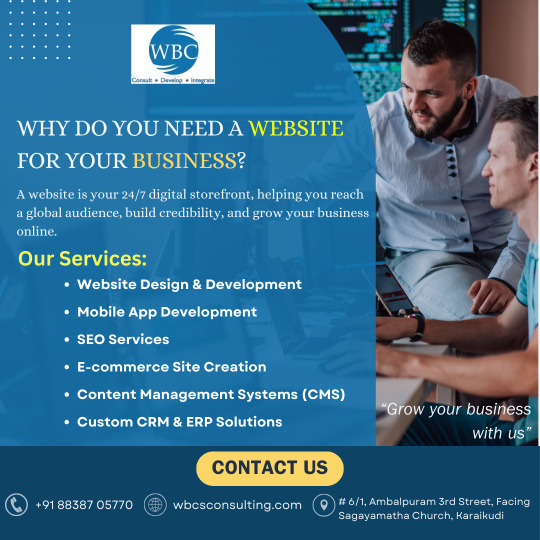
#software development#IT solutions#ERP#.NET#PHP development#Karaikudi#IT training#cloud services#mobile app development#enterprise integration#middleware solutions#Tally ERP#business management software
0 notes
Text
A Success Blueprint: Mastering SAP Integration Migration with NeuVays

In today’s fast-paced digital landscape, enterprise integration is no longer a backend function—it’s a business-critical enabler. As companies increasingly adopt cloud-native applications and operate in hybrid environments, the demand for seamless, scalable, and future-ready integration is rising sharply. That’s why SAP Integration Migration has become a key priority for forward-thinking organizations.
To help enterprises confidently transition from legacy SAP integration platforms to the next-generation SAP Integration Suite, NeuVays is hosting a knowledge-packed webinar titled “A Success Blueprint – PI/PO Migration to SAP Integration Suite.” This live session is designed to offer valuable insights, technical guidance, and strategic approaches to making your integration migration successful, efficient, and aligned with future enterprise needs.
What is SAP Integration Migration?
SAP Integration Migration refers to the structured process of moving from older SAP middleware platforms like SAP PI (Process Integration) or PO (Process Orchestration) to the modern, cloud-native SAP Integration Suite. This shift not only supports emerging integration patterns—such as API-based and event-driven architecture—but also aligns organizations with SAP’s long-term innovation roadmap.
In simpler terms, this migration enables businesses to retire outdated systems and move toward a flexible, agile, and intelligent integration environment that connects SAP and non-SAP systems, cloud applications, and third-party solutions in real-time.
Why SAP PI/PO Migration is Urgent
Many enterprises still rely on SAP PI/PO to integrate applications and orchestrate processes. While these platforms have served businesses well for over a decade, they are increasingly becoming bottlenecks in the cloud era. SAP has already communicated that PI/PO will see reduced investment and innovation moving forward, signaling the need for migration.
Here’s why SAP PI/PO Migration is gaining urgency:
Limited cloud capabilities and scalability in PI/PO
Increasing maintenance costs and technical debt
SAP’s shift to cloud-first innovation and support
Inability of PI/PO to handle modern integration demands (APIs, events, hybrid apps)
To stay ahead, companies must start their SAP PI/PO Migration to Integration Suite today—before end-of-support issues and compatibility limitations hinder operations.
Introducing the SAP Integration Suite
At the core of your SAP Integration Migration strategy is the SAP Integration Suite—SAP’s robust, enterprise-grade integration platform-as-a-service (iPaaS). Built for the intelligent enterprise, the Integration Suite is designed to support a wide range of integration scenarios, including application-to-application (A2A), business-to-business (B2B), and business-to-government (B2G) communication.
Key capabilities of SAP Integration Suite include:
Pre-built integration content from SAP API Business Hub
API management and security tools
Cloud Integration for seamless data exchange across environments
Event-driven architecture support
Centralized monitoring and operations dashboard
AI-based integration advisor for faster design and deployment
It is not only a replacement for PI/PO but a leap forward into intelligent, adaptable enterprise integration.
What You’ll Learn in the NeuVays Webinar
NeuVays’ “A Success Blueprint – PI/PO Migration to SAP Integration Suite” webinar is built around helping enterprises adopt a structured, efficient, and risk-mitigated approach to SAP Integration Migration. The session will focus on real-world insights and proven best practices that can make your migration project a success.
Key Takeaways from the Webinar:
1. Strategic SAP Migration Planning
Discover how to build a comprehensive SAP Migration Strategy that balances technical feasibility with business priorities. From integration landscape assessments to resource planning and phased rollouts, you’ll get a complete migration roadmap.
2. Technical Deep Dive: From PI/PO to Integration Suite
Learn the architectural and functional differences between PI/PO and Integration Suite. Understand how message mapping, adapters, and integration patterns translate in the new environment.
3. Risk Management and Change Control
Uncover methods to minimize downtime, protect data integrity, and manage user acceptance during your SAP PI/PO Migration. Get expert advice on parallel deployment and rollback plans.
4. Real-World Case Studies
See how enterprises in industries such as retail, manufacturing, and fashion have completed successful SAP PI/PO Migration to Integration Suite projects—achieving lower TCO, higher agility, and faster integration cycles.
The Phased Approach to SAP Integration Migration
To execute a smooth SAP Integration Migration, NeuVays recommends a phased approach tailored to your organizational goals and IT landscape.
Phase 1: Assessment
Audit existing PI/PO interfaces and business-critical integrations
Document technical dependencies and custom code
Identify reusability potential for adapters and mappings
Phase 2: Planning
Design the new integration landscape using SAP Integration Suite
Define roles, project scope, and timeline
Choose a pilot process for testing
Phase 3: Execution
Configure and test integration flows in Integration Suite
Rebuild or refactor where necessary
Use migration tools or manual methods depending on complexity
Phase 4: Go-Live and Optimization
Deploy in phases to reduce risk
Monitor integration performance and resolve issues
Train teams and establish ongoing support
Benefits of Migrating to SAP Integration Suite
By transitioning to SAP Integration Suite, organizations unlock a host of benefits:
Cloud readiness: Integrate with SaaS, cloud-native, and on-premise apps effortlessly
Operational efficiency: Reduce the time and cost of maintaining complex middleware systems
Future scalability: Easily scale integrations as your ecosystem grows
Innovation enablement: Leverage AI, ML, and analytics in integration processes
Compliance and security: Centralized governance and enhanced security protocols
This migration isn't just about staying up to date—it's about preparing your business for the future.
Who Should Attend This Webinar?
This webinar is tailored for enterprise professionals responsible for integration architecture, cloud transformation, and SAP platform management:
CIOs, CTOs, and IT Directors
SAP Integration Architects
Technical Consultants and Project Managers
Digital Transformation Teams
Whether your organization is just beginning to explore migration or is already in the planning stages, this webinar will help you avoid costly mistakes and fast-track your success.
Final Thoughts
The path to modernization starts with bold decisions and trusted expertise. SAP Integration Migration isn’t just a technical project—it’s a strategic transformation. NeuVays’ upcoming webinar “A Success Blueprint – PI/PO Migration to SAP Integration Suite” offers you the expert-led guidance needed to navigate this complex journey with confidence.
If you’re ready to improve integration performance, align with SAP’s innovation roadmap, and build a truly intelligent enterprise—this webinar is your starting point.
🔗 Secure Your Spot Today
Seats are limited for this exclusive session. 👉 Register Now 👉 Connect with NeuVays SAP Integration Experts
#sap integration suite#sap integration#sap pi/po#pi/po migration#sap migration#sap pi/po support ends
0 notes
Text
Digital Integration Solutions with Cloud-Based Architectural Design
W3 Partnership, founded in 2007, provides solutions and services that help organizations make sense of their digital applications and services through integrated platforms and patterns. SMEs in their respective fields, our in-house integration consultants are specialists in IBM and MuleSoft products, and our cloud consultants and developers are experts in AWS and Azure. We design, develop, manage, and monitor such platforms.
At W3 Partnership, we specialize in delivering integration connectivity as a service (iCaaS), cloud-based integration solutions, and middleware integration consultancy tailored to your unique needs. With decades of expertise, we empower businesses to streamline operations, eliminate silos, and drive innovation through hybrid integration platforms and advanced digital integration architecture services. Using advanced requirements analysis and digital integration architecture techniques, we collect all the necessary information to enable efficient stakeholder communication, ensuring a smooth transition from analysis to implementation.
Architecture Digital Integration
A data architecture called a Digital Integration Hub (DIH) separates the digital applications of the SoRs and compiles operational data into a low-latency data fabric. Organizations may connect to, integrate, and manage various software applications and systems using this architecture. To simplify data exchange and automate business processes, Architecture digital integration provides a central hub for managing the data flow between different systems. A digital integration hub supports modernization efforts by delivering a detached API layer that easily supports current online apps.
Digital Integration Solutions
An organization's digital transformation journey heavily depends on integrations to create a connected business. With the potent combination of innovative integration tools, intelligent methodologies, tried and tested templates, carefully designed organizational frameworks, and our knowledge and experience. Technology solutions known as "digital integration solutions" make it easier for digital systems, apps, and data sources to communicate and exchange data. They give firms a capacity to integrate many systems, optimize processes, and use data from various sources to make better decisions and provide better customer service.
Cloud-Based Integration
In today's digital-first business world, cloud-based integration serves as the cornerstone for tying together systems, data, and applications. Our cloud-based integration services at W3 Partnership effectively connect on-premises systems, cloud applications, and third-party solutions to form a cohesive digital ecosystem. Our solutions, built with agility, scalability, and security in mind, simplify IT, enhance data accuracy, and facilitate real-time data exchange, enabling your teams to make data-driven decisions more quickly. W3 Partnership's cloud-based integration strategy utilizes API-led connections and sophisticated integration platforms to help companies rapidly and affordably integrate apps. Our cloud-based integration services simplify the connection of marketing tools, CRM systems, ERP platforms, and data analytics applications while ensuring data accessibility and integrity.
1 note
·
View note
Link
0 notes
Text
Top Blockchain Application Development Services in 2025
Over recent years, the blockchain sector has reached a certain level of maturity. Adoption is currently peaking across industries such as banking, healthcare, logistics, and digital identity. Hence, businesses are not tinkering with blockchain anymore; they want to build real, scalable solutions. Providing Blockchain app development services forms the backbone of these innovations, assisting businesses in transforming their decentralized concepts into reality through expert consultation, development, and support. Such services become vital for any company wishing to stay ahead, cut inefficiencies, and forge a secure digital ecosystem worthy of user trust.
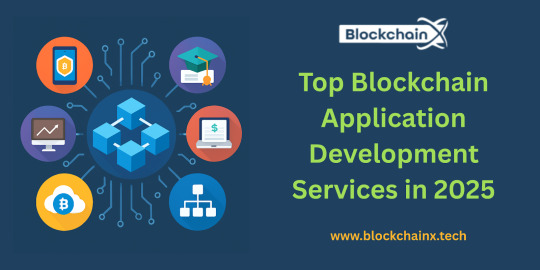
1. End-to-End Blockchain Consulting and Strategy
The very start of any successful blockchain solution rests upon a strategic foundation. Top engineers don't just dive into writing code but guide you in every step of crafting a solution. In general, the consulting process comprises the identification of use cases, choice of the right blockchain protocol (be it Ethereum, Solana, or Hyperledger), and if applicable, the designing of tokenomics. This is followed by an assessment in 2025 of how scalable, interoperable, and fit within regulations each solution is considered to be. They then begin working alongside the stakeholders in defining the milestones that they must achieve on the path to avoid technical pitfalls and create a realistic roadmap that aligns itself with the short-term objectives and the long-term vision of another party. Hence, this layer ensures that strategic projects are not built and their success lies within this frame.
2. Smart Contract Development
Smart contracts are programmable engines behind almost every blockchain application. These contracts self-execute, thereby removing intermediaries, limiting chances of fraud, and allowing for consistent execution. In 2025, top-tier blockchain development firms provide high-end smart contract development with a few extra features such as gas optimization, modular logic, upgradeability, and a fluid way to consume external data from oracles. The companies undertake further testing in testnets and audit across tools and manual auditing. Whether you are trying to build a DeFi protocol, an NFT marketplace, or a DAO voting system, the backbone is a good smart contract that is usually ensured by top developers for strength and safety.
3. dApp Development Across Multiple Platforms
dApps are becoming crucial to countless industries, their doors open to censorship resistance, user control, and global reach. The most trusted blockchain app developers in the year 2025 will provide full-cycle dApp development, beginning with user-centric design and finalizing with a rock-solid backend infrastructure and blockchain layer integration. They have the capability to make the application cross-chain, like Ethereum, Avalanche, Arbitrum, or BNB Chain. Services also extend to wallet integrations (such as MetaMask and WalletConnect), gasless transactions, and token gating. Furthermore, the professionals are now including AI capabilities inside the dApp for enhanced user experience, workflow automation, and decision support.
4. Blockchain Integration with Legacy Systems
Many enterprises operate on legacy infrastructure that simply does not support decentralized applications. Yet, the best blockchain service providers foster the capacity to address this gap through custom-built middleware solutions. These integrations connect the blockchain networks with CRMs or ERP systems such as SAP or Oracle; cloud environments, including AWS and Azure; and conventional databases. With such advanced feature capabilities as real-time syncing, event triggers, and data mirroring between the on-chain and off-chain layers, companies can go the last mile and apply blockchains in operations without interrupting any processes. Moreover, besides acting as technical compatibility services, they add alternative layers for compliance and audit trails that regulated industries may require, such as finance and healthcare.
5. NFT and Tokenization Solutions
NFT technologies will make everything possible to be tokenized across industries everywhere in the year 2025-from tokenizing of properties, luxury items, digital identities, to academic credentials. Major blockchain developers deliver an end-to-end NFT solution including token creation (ERC-721, ERC-1155, etc.), marketplace development, cross-chain minting, and intricate advanced metadata management. Compatibility with legal regulations incorporating royalties, auction systems, and secondary sale mechanisms is also considered. With an increasing demand to tokenize real-world assets, companies are relying on experienced developers to build secure, scalable platforms that enable liquidity and digital ownership.
6. Private and Consortium Blockchain Development
Private blockchain systems, and more so consortium ones, are preferred in many businesses to control access, increase transaction speed, and maintain confidentiality, in contrast to public systems that are ideal for transparency. Custom solutions are provided by blockchain developers in 2025 using Hyperledger Fabric, R3 Corda, and Quorum, among others. These services include setting up the network, managing permissions, deploying smart contracts, assigning roles and access, and more. Defining governance structures will also be aided by them together with processes for onboarding and rules for consortium members. For industries such as supply chain, insurance, or healthcare, where privacy and control are a top concern, these private blockchain solutions strike a perfect balance between innovation and compliance.
7. Blockchain Maintenance and Support
Once your blockchain application goes live, it needs to be continuously monitored and maintained to remain functional, secure, and updated. The elite service providers offer 24/7 monitoring, performance optimization, scalability improvements, and bug fixing on the fly. They provide dashboards for real-time analytics and support upgrades when protocols differ and even have features for end-user support. A proactive approach to maintenance will ensure that your blockchain app continues to deliver value, adapt to user demands, and comply with network upgrades or regulatory mandates. Long-term support is especially vital in keeping up with the rapid advancement brought about in the blockchain landscape.
8. Web3 Wallet and Exchange Development
Since wallets and exchanges make the bridge to the blockchain world, they have to act as the foundational pillars of Web3. By 2025, crème de la crème developers will be building Web3 wallets furnished with biometric login support, multi-chain token support, staking options, and DEXs-in-the-app themselves. They also make sure to engineer safe, compliant crypto exchanges, both decentralized and centralized, bearing features such as real-time trade engines, liquidity management, fiat gateways, and user verification workings. The applications should support heavy load, attack resilience, and have a flawless user experience on a desktop as well as on mobile.
Conclusion
The increase in blockchain adoption in 2025 changed the transparency, automation, and security expectations of conducting business. However, developing a successful blockchain solution requires more than just passion: it takes skills, planning, and execution. The greatest opportunities decentralization has to give are granted to those who choose a firm that offers trustworthy, scalable, and future-ready custom blockchain app development services. When it comes to solving business problems through blockchain, smart contract development, dApp development, NFT development, and enterprise blockchain development, the right partner will ensure that the blockchain story of the client is both creative and meaningful.
0 notes
Text
Building Scalable Web Applications with ASP.NET Core
In the ever-evolving world of web development, building applications that can grow with user demand is critical. ASP.NET Core, Microsoft’s powerful open-source framework, is trusted by developers worldwide to create high-performance, scalable web solutions. To gain hands-on expertise in this robust framework, consider enrolling at the Best DotNet Training Institute in Hyderabad, Kukatpally, KPHB, where expert instructors and practical sessions help turn learners into professionals.
Why Choose ASP.NET Core for Scalable Apps?
ASP.NET Core stands out due to its modern architecture and performance-first approach. It’s lightweight, modular, and built from the ground up to support cloud-based and enterprise-level applications.
Cross-Platform Development: Write once, deploy anywhere—Windows, Linux, or macOS.
An efficient web framework: It's one of the fastest frameworks on the market.
Microservices Ready: Easily build and manage microservices with Docker and Kubernetes support.
Core Features Supporting Scalability
Asynchronous Programming
ASP.NET Core's support for asynchronous programming allows applications to handle multiple requests efficiently, minimizing latency even under high loads.
Built-in Dependency Injection
This helps manage complex application dependencies cleanly, allowing better control and scalability.
Middleware Pipeline
Customize the request-response pipeline to ensure efficient data handling, performance tuning, and modular control.
Integration with Modern Tools and Cloud Platforms
ASP.NET Core seamlessly integrates with:
Azure Cloud Services for flexible deployment and scalability.
Entity Framework Core for efficient data access.
SignalR for real-time web functionalities.
Front-end libraries like Angular and React for building full-stack applications.
These integrations empower developers to build feature-rich, cloud-native applications that scale as user demand grows.
Community Support and Continued Growth
ASP.NET Core benefits from a strong global developer community and regular updates from Microsoft. You’ll find thousands of tutorials, forums, and open-source projects that accelerate your learning and problem-solving.
Conclusion
Developing scalable web applications is no longer optional-it's a fundamental requirement. ASP.NET Core offers the flexibility, performance, and tools needed to build apps that grow with your business. To truly master it and launch a rewarding development career, consider training with Monopoly IT Solutions, where real-world projects, expert trainers, and career guidance await.
#best dotnet training in hyderabad#best dotnet training in kukatpally#best dotnet training in kphb#best .net full stack training
0 notes